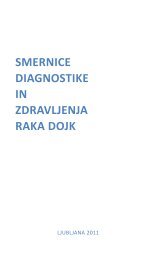You also want an ePaper? Increase the reach of your titles
YUMPU automatically turns print PDFs into web optimized ePapers that Google loves.
The influence <strong>of</strong> hypoosmolar medium and electric field on cell volume<br />
Marko Ušaj, Katja Trontelj, Maša Kandušer, Damijan Miklavčič<br />
Faculty <strong>of</strong> electrical engineering, University <strong>of</strong> Ljubljana, Tržaška 25, SI-1000 Ljubljana, Slovenia<br />
Cell electr<strong>of</strong>usion is a process where two or more cells exposed to electric field, which are<br />
in close contact, fuse. The consequence <strong>of</strong> exposure to pulses is transient and nonselective<br />
permeabilization <strong>of</strong> cell membranes, which is necessary for fusion <strong>of</strong> cell membranes.<br />
Besides optimal electrical treatment, good physical contact between cells is necessary<br />
for achieving cell fusion. In this context, it is understandable that fusion <strong>of</strong> adherent<br />
cells is common event, while it is difficult to obtain sufficient contact between cells in<br />
suspension.<br />
Cell swelling facilitates the processes <strong>of</strong> electr<strong>of</strong>usion. For achieving contact between cells<br />
in the process <strong>of</strong> electr<strong>of</strong>usion, different methods are used, which use either electrical (in<br />
dielectrophoresis) or mechanical forces (in centrifuge, on filters…). Cells swell, when they<br />
are suspended in hypoosmolar medium. Knowledge <strong>of</strong> swelling kinetics could contribute<br />
to optimization <strong>of</strong> the methods for contact achievement.<br />
We determined the kinetics <strong>of</strong> cell swelling for three different cell lines: Chinese hamster<br />
ovary cells CHO, Mouse melanoma cells B16F1 and Chinese hamster lung fibroblasts<br />
V79. All cells under investigation start swelling immediately after exchanging the<br />
isoosmolar medium (10 mM phosphate buffer, 1 mM MgCl<br />
p46<br />
2<br />
, 250 mM sucrose, pH 7,2<br />
and low conductivity 0,12 S/m) with hypoosmolar (75 mM sucrose). However, they reach<br />
their maximum size value at different time after the change (between 2 to 5 minutes) and<br />
differ in the speed <strong>of</strong> shrinking as well. We observed diameters <strong>of</strong> cells for 30 minutes after<br />
the medium exchange. In this period, cells shrunk to their original size due to regulatory<br />
volume decrease. When we kept cells in isoosmolar medium, they did not change their<br />
size.<br />
Cell swelling is also observed after electropermeabilization. We determined the influence<br />
<strong>of</strong> combination <strong>of</strong> electropermeabilization and hypoosmolar medium on cell size. We<br />
electroporated cells 1 minute after exchanging the medium, that is before cells reach<br />
their maximum size. We used electrical parameters, which are optimal for transient<br />
permeabilization <strong>of</strong> cells in isoosmolar medium. Electropermeabilization abolished the<br />
effect <strong>of</strong> regulatory volume decrease during the 30 minutes <strong>of</strong> our observation.<br />
128
















